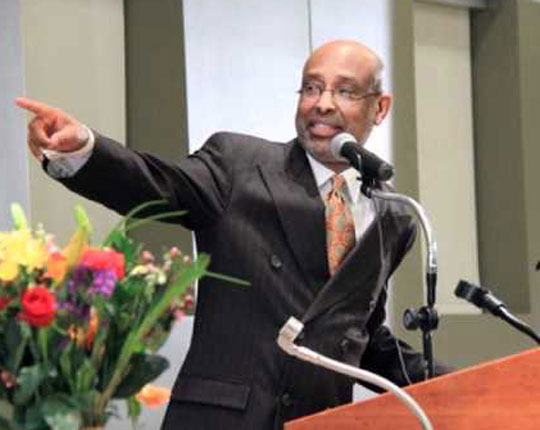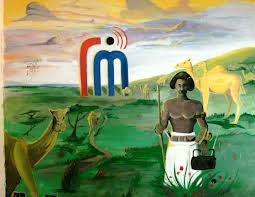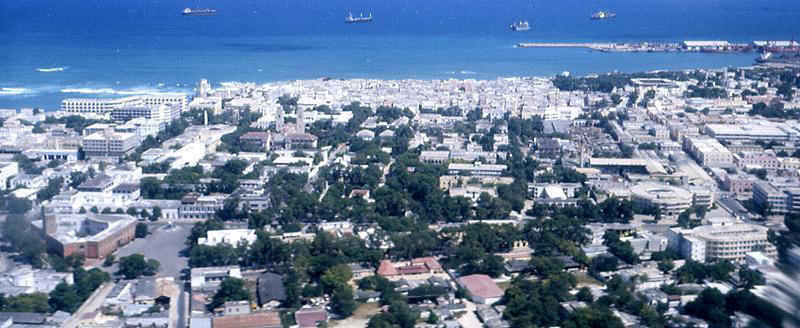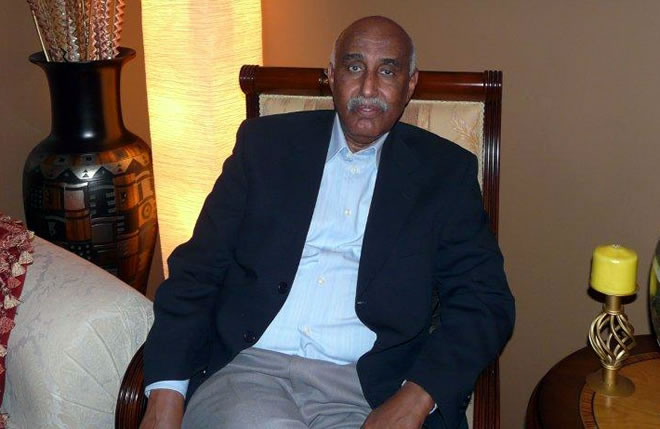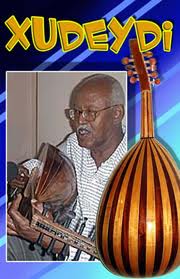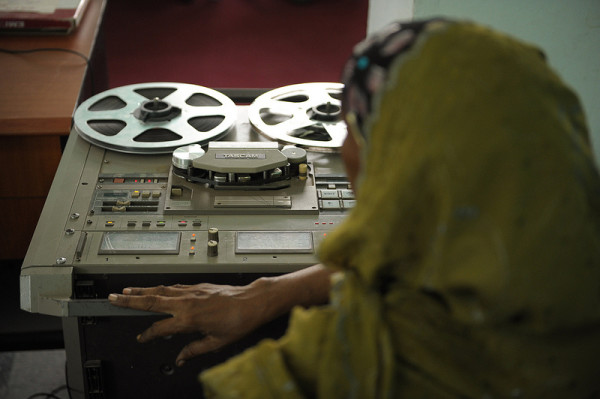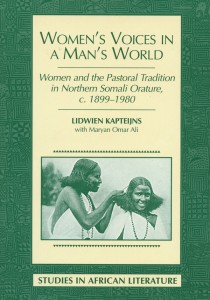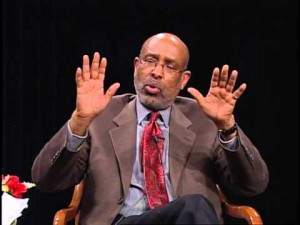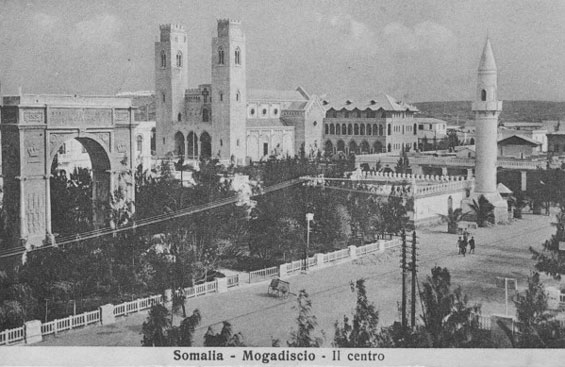Ahmed Ismail Samatar is a professor at Macalester College in St. Paul, MN. Minnesota is home to America’s largest Somali-descended population, over 32,000 people, according to the 2011 census. Professor Samatar has taught at Macalester for 20 years, 18 of these as Dean of International Studies and founding Dean of the Institute for Global Citizenship, so he has watched this community grow. As Afropop’s Banning Eyre learned, Professor Samatar has accumulated a vast record of academic scholarship on Somali society and civic involvement at the highest level. Here’s their conversation, recorded for the Afropop Worldwide program, “Reconstructing Somalia: Romantic and Nationalist Songs at the Birth of a Nation.”
Banning Eyre: To start, introduce yourself and tell us a bit about your professional background, and your early life. Tell us how you came to this country, and how you got involved with Somali poetry and music.
Ahmed Samatar: Well, my name is Professor Ahmed Ismail Samatar. I am the James Wallace Professor of International Studies at Macalester College. I have been here for 20 years. For 10 years before that, I was a professor at St. Lawrence University in upstate New York, in the Department of Government. My degrees are in the areas of global political economy, social theory and African politics. There's a concentration on state formation, development challenges and conflicts, not only in the global south, but other zones of the world too, as part of a larger historical process that has challenged human beings, and continues to confront them as we speak.
I was born in Western British Somaliland, now called Somaliland, in a small town, not too far away from the capital of Somaliland, Hargeisa. The small town is called Gabiley, about maybe 40 km to the west. It's primarily an agricultural area. The town was founded I think at the turn of the 20th century, primarily small-scale commercial life, but also small-scale agricultural production in the zones around the town. This is where my great great grandparents settled in the 1820s or so.
I was introduced to Somali music as a young boy, Somali musical culture, not so much first with the music itself and songs, but through poetry—poetry and dance. This is dance that is accompanied by a kind of a cappella singing. It is very old in Somali culture, hundreds of years old. And that really precedes song-making with music. Song-making with music is mid-20th century, maybe 1930s, 40s, I think.
So I grew up in a family in which poetry and dance, traditional dance with voice accompanying but no music, was part of the landscape for generations. In fact, some of the iconic figures in Somali poetry and in drama-making, come from my family, my extended family. We might want to talk about some of them, like Abdillahi Suldaan Tima’ade, probably the greatest Somali poet in the 20th century, certainly in the last 80 or 90 years. He died in 1973. Also Hassan Sheikh Mumin, whom we will talk about a little later. He is one of the supreme figures in playwriting in the last 80 years or so.
So I was born into in that kind of an environment. And then, as I was growing up, Somali music came of age in its classical sense in my consciousness, and I began to develop a taste for it, and I think I have been very much hooked to this day.
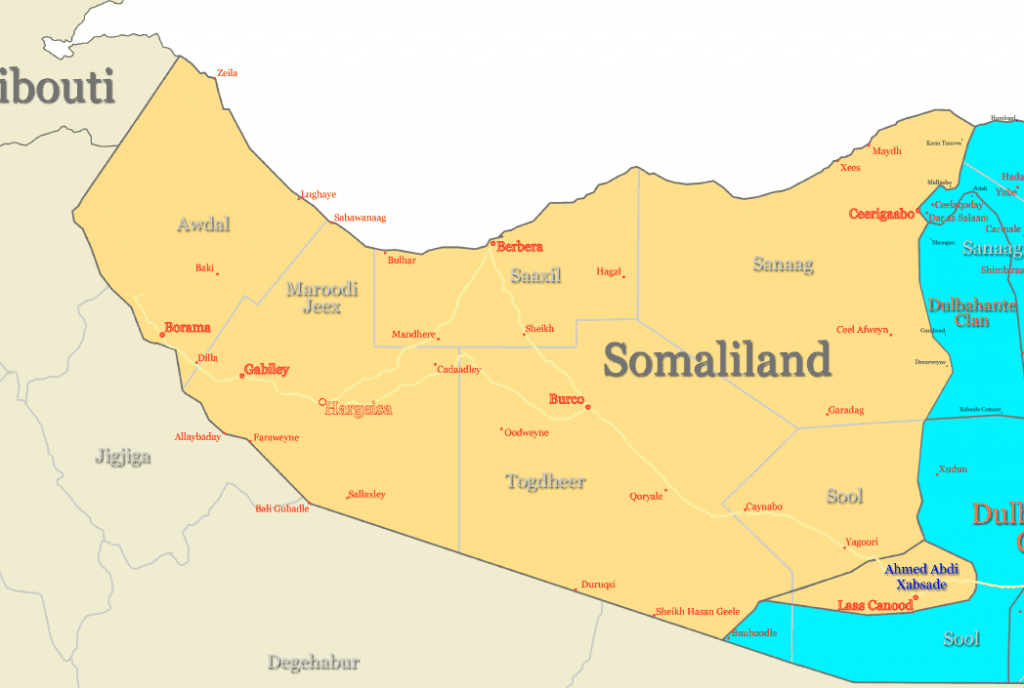 Great. That's a terrific introduction. So our program is really focused on the popular songs of Somalia between 1955 to 1990. So to start, I'd like to hear from you generally how these songs figured up in your experience, first, as you were growing up in the northwest, and then in Mogadishu, when you became professional at Radio Mogadishu. Tell us how these songs came into your life, and what they meant to you.
Great. That's a terrific introduction. So our program is really focused on the popular songs of Somalia between 1955 to 1990. So to start, I'd like to hear from you generally how these songs figured up in your experience, first, as you were growing up in the northwest, and then in Mogadishu, when you became professional at Radio Mogadishu. Tell us how these songs came into your life, and what they meant to you.
Well, before 1955 I can't remember much, because I was too young, barely five years old. But around the 1960s, I began to get a good sense of what was around me, the cultural endowment of the Somali people, certainly in the '60s and '70s, up to the present day. I was introduced to this, as I said earlier, first through poetry, which was part of the conversation in my household. My father and my grandfather (the significant elder) were business people. My father was the first person to leave the pastoral world behind and enter the commercial, capitalist, urban-based society, and my father then became kind of a major businessman in that small community.
So, because there was enough surplus at home, people would come and eat with us, and sit and talk and have tea with us. And their conversations would be about the affairs of the community, serious affairs of the community, in terms of life and death, and the needs of poor people at that given time. Inquires were made about whether there were enough rains or not, because water is a precious thing in the Somali landscape. The condition of farming and harvest that particular year, all kinds of issues, marriage, birth and things like that. But after all of these kinds of immediate issues are dealt with, then people would relax and they would be talking about what they called “deep culture.” That is, poetry particularly and what that meant for them.
And in the late '50s, I became somewhat conscious about this, since I was coming of age as a young person entering my teens. I found out that at that particular time, there were many kinds of developing and sprouting Somali classical verse, at least at the level of the musical composition, and the instruments that are essential--and to this day, really, we identify Somali classical music in its most profound, seductive form and rhythm with oud--the center of gravity of Somali music. You can do many creative things with the oud only. If you don't have the oud, there's not really much you can do with Somali music in the classical sense. The oud is usually accompanied by drums, and then the third instrument is the flute. So I could hear that, and the sweetness of that combination.
Songs, modern Somali songs, from then on, go into a variety of dimensions. There are some that speak about the ecology of the environment, which is always pressing hard on the Somali people in the Horn of Africa, because this is the Sahel region. The weather can be quite severe at times. Droughts, for example, are an important subject. People talk about the threat of drought. Then when the rains come and livestock are producing, there's plenty of milk and meat to go around, and there is a different kind of song that would be composed to celebrate that. Weddings, death, birth of children also generate a great deal of musical emotion.
But maybe the two most important themes in Somali classical music are: love, lost or gained love, and then nationalism, as the decolonization process was gathering momentum in the 1950s. With the coming of independence, we faced the challenge of building a productive civil society. These, I believe are the two richest dimensions of Somali classical music.
Tell me a little bit about Radio Mogadishu, how you came there first, and then a little about its importance in spreading awareness of the songs.
Well, I went to a boarding school in Somaliland, about 90 miles from Hargeisa to the west, in a very beautiful region, hills and wonderful climate, a cool climate three or four months of the year. It's a bit higher elevation. It's called Borama, and the British established a boarding school (Amoud), about five miles away, where my parents sent me for eight years. Borama is a city now, with over 250,000 people. Three years after independence in 1960, I was one of the youngest kids to go to that boarding school, what the British called intermediate school. In American language, that would mean junior high, for four years. And then another four years of secondary school, or senior high school.
Once we finished there, then we had to look for either employment or, mostly, given the fact that we were a very small group of students at that time in Somaliland, we had to look for scholarships—especially if you wanted to go to university, because there were no universities in the country at that time, either in the south or in the north. So everybody went to Mogadishu then. And, like all developing countries in the global south, everything is concentrated in the capital city. This is one of the consequences of bad development, development that is poorly designed. Everybody comes to the source of decision-making and power. The capital city, in a way, is like a great vacuum cleaner, sucks the life out of the other regions of the country. That's one of the things that went wrong in Somalia, I think.
So we went to Mogadishu, which was quite distant from where I was. I was coming from maybe the most remote part of what used to be called the Somali Republic, in the extreme northwest. We traveled by road, so it took us almost four days to get there. And when I arrived in Mogadishu, all of us, from different schools, came there to compete for whatever there was of scholarships or jobs.
I was always interested in becoming a young broadcaster, because I was fascinated by the radio when I was in boarding school. I would talk to my classmates and the end of the evening, we had done our homework. I would ask them to listen to me, and I would pretend to be reading the news or something like that, for almost a year while I was in Amoud secondary school.
So I had some practice in this when I applied for a job in Radio Mogadishu. They advertised three positions for apprentices in the business of broadcasting, to be later trained to become newsreaders for the national network. And I participated in that competition. There were 77 of us. It was a grueling week, with different kinds of examinations from writing composition and commentary, to a voice test, to oral translation from English into Somali. Somali wasn't written at that time. I was fortunate to be the first person, the top person in the exams, and I got the appointment at Radio Mogadishu and began to study as an apprentice under the shadow of some of the great Somali broadcasters in the national network. I did that for about nine months, really three months of intensive training and about six months of actual broadcasting. I was barely 17 years old when I began broadcasting at the national network, Radio Mogadishu.
And all around me at that particular time was the archives and the library of Radio Mogadishu, which was thick with all kinds of recordings from the past. And every day, the artists who were congregating around Radio Mogadishu, would be recording new songs. I was in that universe, every minute of my professional day. My appetite for Somali music and song, and voice, became much more developed, and I acquired some knowledge about the varieties of different artists, and deepened my appreciation for the pivotal place of song-making, playwriting and acting in the theater. All of those artistic Somali capacities were exceptional. I began to internalize this through very close encounters.
That's fantastic. Such a rich description of that moment. Let's talk about some of the important figures you have known. I believe the playwright Hassan Sheikh Mumin was your uncle, right? And then I’d like you to tell us about the oud player and musician, Ahmed Ismail Hussein, also known as Hodeidi.
Good. But I would like to actually start with one other person. He was also very close to our family, a distant uncle. I saw him very frequently as a young boy and listened to his recitations. This is Abdillahi Suldaan Tima’ade, who, in my books, and I think in general consensus, is the greatest Somali poet in the last maybe 80 years or so. He was from the same town I was from, and a relative of my mother. So he would come to our house quite frequently when were small boys. Tima’ade is a nickname—most Somalis, except perhaps me, have nicknames. Tima’ade means "the one with the white hair," because he had early graying when he was relatively young. And in fact he died young. I think he was in his mid-50s.
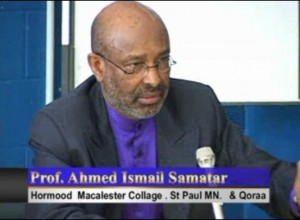
Tima’ade was an iconic figure in composing poetry of the highest quality that was touching and that dealt with issues of colonialism and liberation, and the challenge of building a democratically capable state where justice and competence were the key. But he also had two other distinctions. One was that he could speak about the future as if he has already been there, and only later on, when that future arrived, whether it was a year or 10 years or 20 years, did people realize this. He had this premonition of what was to come, and he would tell the Somalis in poetic form what to avoid and what to hold onto. We were very poor listeners as people, and the regret now is quite pervasive.
The second thing that he had, beside the richness of his vocabulary as a great poet, was his voice. He had a special, absolutely distinctive way of reciting with a beautiful voice, a singing voice. He was the only one who could do it that way. He could sing at the same time he was reciting this heavy, classical Somali poetry. And his voice was just enchanting. Once he opens his mouth, and you hear that, there was no escape. You had to just sit and listen to this. It was magical. So Abdillahi Suldaan Tima’ade for me was the first person that initiated me into this as I began to grow under his huge shadow in Gabiley.
The other person that you have mentioned, Hassan Sheikh Mumin, was probably one of the two or three great playwrights of Somali society ever. He was more educated than many of the other great playwrights. There were quite a few others, but he was distinctive in a variety of ways. One, because he was more educated, almost a genius level. He was the only Somali playwright to this day who could compose and write two plays simultaneously. It's like writing two books at the same time. Nobody else had that capacity, that kind of depth of talent and imagination and skill.
The second thing—and other artists and poets and playwrights have spoken about this--he was gutsy—he had enormous courage. Authority never frightened him. Power never intimidated him, and he would speak the truth the way he saw it, with a great deal of elegance, of course, not vulgarity—just courageous and gutsy. That was Hassan Sheikh Mumin's distinction, and in many ways he was the greatest Somali playwright that the world has come to know. His play Shabeelnagood, for example, which is about the predatory nature of men in terms of Somali culture with regard to women, especially the level of young people— has become a classic, translated into English. You can find it in libraries whether you are in Australia or Malaysia or the United States or Britain.
And then there is Ahmed Ismail Hussein, Hodeidi. He is also incomparable. His major talent is his oud-playing. In my opinion, the most distinguished and pioneer oud player. He’s still alive. I think he's in his late 80s. He lives in London. I just saw him in January. We were in a place together where I was giving a lecture, and he was playing to the crowd
Hodeidi
before I arrived. Just electric and mesmerizing. His craftsmanship is unparalleled among Somalis. He has become the gold standard in the virtuosity and craftsmanship of Somali oud playing. He has had enormous effect on the generations after him, to this day. Many of his students, now in their 30s and 40s and 50s and 60s, are at the supreme level. So Hodeidi has become a kind of a grandfather of Somali oud players. And he could play all kinds of songs, and make them sweetly complicated in the best sense of the Somali tradition in performing with the oud. Hodeidi also has a significant capacity to compose songs, and one or two of his songs have now become classics, known everywhere among Somalis of a certain age. When he is playing, people will ask him to sing some of these songs, even though is voice is average, compared to his talents as an oud player.
So that's Hodeidi. Hassan Sheikh Mumin is not with us anymore. He died a few years back in exile. Abdillahi Suldaan Tima’ade died in 1973. Most of the greats are dead. Hodeidi might be one of the last alive today.
That's wonderful. Now, I have looked on commercial sources, like Amazon.com. I don't find any of his recordings, just a few YouTube videos.
Very difficult. All Somali music is very difficult to find, because it is not fully commercialized. It is very underdeveloped in that sense. To find out about an artist like Hodeide, you have to be inside the Somali musical culture. People have got their own private collections, and archives—someone like Maryan Omar Ali, who was probably the most important collector of Somali music and songs. Professor Kapteijns worked with her on her book, Women’s Voices in a Man’s World. But only those who are inside the track know when Hodeide is playing. I'm not sure whether you can find any of his songs in any public place.
That's fascinating. I think that these days, people think that you can find anything. And it's not true.
Not quite true. Not quite true at all.
Radio Mogadishu archive
Let's talk about some songs, and then we'll end with talking about your current work at Macalester, and some of the people you've been able to bring there. Tell me about a few of your personal favorite qaraami songs, and what they have meant to you.
Well, I have always been, to this day, attached to classical Somali music, much like the scholarship that I read. When I write, I am more of a classical person than trying to run with the latest fad at any given time, either in the academy, or in Somali cultural production.
O.K. Fair enough. When we talk about qaraami songs, Professor Kapteijns calls them "popular songs." You call them “classical.”
Yes, yes, I do. You can have popular songs right now that were created last night and last year. Popularity for me in something that is in the consciousness of people, at a particular time. People play and use them for entertainment or aesthetic pleasure. For me, classical works are those who have stood the test of time, and they underscore the foundational basis of Somali song production. So qaraami songs in that sense would be, for me, classified as classical. And people who play or sing the qaraami always hearken back to another era, to another time. I can't think of any qaraami song, really, that has been composed, for example, in the last 10 years. There are pretenders—young people and others who do try to do that. But Beethoven is Beethoven. People might try to go beyond him, but they will never be Beethoven. So it’s the towering, pioneering pieces of work that have now become part of the great, deep treasure of Somali musical culture—that's what I mean by classical or qaraami.
O.K. And many of these are indeed the same pieces Professor Kapteijns calls “popular,” so it’s really a difference in perspective, I suppose. Anyway, we’re looking at the period of 1955 to 1990. So pick your examples from somewhere in that time frame.
Right, right. Well, of course, there are many, dozens and dozens. But for me, three songs stand out. One is a song that, for many people, stands as part of the first chapter of the production of Somali classical songs. And it is called "Jowhara Iyo Lula," which concerns love. A young man is in love with a woman, a young woman, and he makes the point that this woman who is so attractive to this particular man is powerfully seductive, and so beautiful that she is like a precious stone. And that song, therefore, opens up a whole universe of love spoken in public and romantic imagination inserted into the public aesthetic expression. The spirit of the song is celebratory—a sort of a high note. Both men and women can sing this, by the way, and usually it's done in a form called darandori, and that means a man and woman are singing this, and they rotate with the musical instruments, the lute, and the flute, and the drums, and the voices, as they exchange the singing. It's very melodic and beautiful, "Jowhara Iyo Lula."
The second one is a bit younger than that, but this too is composed in the early '60s, if not late '50s. "Jowhara Iyo Lula" is certainly '50s, early '50s. This is a song called "Berdelaashe." The little translation would be, well, ber is the Somali word for liver, literally translated. But I think what it means is not really the liver, but rather, the heart. So "Berdelaashe" means the love that has slashed the heart. It's a composition that is very painful, expressing great deal of agony. So while "Jowhara Iyo Lula" is a celebration with the sparks flying between the two people, “Berdelaashe” laments lost love.
"Berdelaashe" also is composed by a pathfinder in Somali classical music, and the production of Somali songs. His name was Abdillahi Qarshe. In fact, he is the person who first showed Hodeidi how to play the oud. Hodeidi would then surpass him. But this is one of the great compositions of Abdillahi Qarshe, who died in London, I think about 15 years ago, in exile. As I said, this song is full of sorrow, but it is fantastic when it is sung
Abdillahi Qarshe
well with the accompaniment of the oud and the drums and the flute. And it is one of the most difficult of Somali songs to actually play and sing, because it starts at a very deep low pitch, and then you have to go through so many different levels, all the way up, and then you have to come down. It's almost like climbing up a four-story building, maybe even higher. So you have to start from the basement, and then go up, and then come down! It is challenging for the best among us. Even for the great Somali singers, men and women—like Mohamed Souleyman, or Magool, or Mandeeq or Hiba Mohamed, or accomplished male performers like Omar Doule—it’s not easy.
And then the third one that I would mention is also an older tune, quite old. But it is extraordinary. It's called "Gooh", and gooh means in Somali basically a rendition or a voice that is at the very low level, deep and low level. It is a song that is performed in a variety of styles, but the deep rhythm is usually the same, and that song, we are told, was born in a conversation, maybe even a tug-of-war, between two families. One family, who's livelihood was grounded in pastoral life—basically pastoralists, primarily camels and goats and sheep and livestock of that kind—and those who were in the coastal zone in Zeila, one of the oldest cities in Somaliland, and a place culturally linked to fishing. So a contest between pastoral life and fishing life. Two families. Now the young woman is from the pastoral life. The young man she falls in love with is from a fishing community, and they struggle between those two cultures. Because nomadic people arrogantly believe that they are culturally superior; they look down on every other community, from cultivators to fishing people. The family wants their daughter to marry someone from the pastoral sector. But she's in love with this young man who's in the coastal area, from a fishing family. And so the song unfolds in the encounter between them.
Faisal Omer Mushteeg
A fourth and final one I would suggest is a bit more modern, from the late 1960s. It's in the form called sub'is, and it is composed in fact by one of my teachers. He died I think about two years ago in Hargeisa. His name was Faisal Omer Mushteg, and, actually, this is a true story. He fell in love with someone from the same community that I come from, a young student in school. She was one of the first Somali girls to go to school, and an extraordinarily attractive one. She lives in Canada now. She married somebody else, and broke his heart, and "Sub'is" is kind of his beautiful lamentation about heartbreak. So those are some of the ones I would suggest.
That's wonderful. Thank you very much. I understand that these songs, especially in the ’50s and ’60s and ’70s, are dealing with the whole process of Somalia trying to make itself into a nation. When you talk about the song "Goosh," and the challenge of the pastoral, nomadic and cultivating or fishing communities making common ground, that seems really go to the heart of the challenge of nation-building in Somalia at that time. You were living in the midst of all that as a radio broadcaster. How did you experience it? Did you really feel that music was playing a role in unifying the country?
Well, two comments. The first one is just to alert you to Professor Kapteijns's association and collaboration with Maryan Omar Ali, the splendid archivist. They wrote a book on what they call “popular songs”— classical, at least in my terminology—but that's an excellent piece of work, both as a scholarly volume, but also as a kind of repository of information. That kind of work has never been done before. The title is Women’s Voices in a Man’s World.
In so far as the role of Somali classical song-making is concerned, there's a whole genre that is quite patriotic, or internationalist. And some of the great Somali singers have made their name in that. Someone like Bahsan (Zeinab Haji Ali "Bahsan"), for example, who might be seen, at least in my estimation, as probably the best nationalist singer, purveyor of nationalist songs. A wonderful voice, and she can belt out these moving, emotionally loaded, patriotic songs, almost like Umm Kulthum in Egypt, for example—someone like that. But all of the major singers would perform these patriotic songs.
Ahmed Ismail Samatar
I think songwriting and playwriting, and acting in those theater centers, in Mogadishu, in Hargeisa are unforgettable. Hargeisa really was the more eminent in many ways. The northern Somalis are gifted in this area. The southern Somalis have a talent for orchestral music-making. They could play many different instruments, whether it's the accordion or the violin or the piano, clarinet or saxophone, or even the electric guitar. The northern Somalis excel in composition and singing—riveting voices, enriched by high quality of the composition and playwriting. The most distinguished playwrights of that epoch were often from the north. So is the case with some of the supreme singers, men and women.
Songs, playwriting and acting together are high water marks, and excellent plays usually produce new and fantastic songs, songs for the ages! When that comes off, it generates heavy emotions, and a great deal of that was invested in raising the consciousness of nationalism, whether that is the time of decolonization in the 1950s, or—most important—after 1960, and the building up of a national identity. Maybe the most important initiative from the Somali culture was in trying to buttress the new state and give it a nationalistic form that was working for everybody and could handle the issues of justice, competence, and development and progress.
That's beautiful.
I think one other quick item I want to add is the Somali national project as a new nation had two fronts. One is the domestic dimension of the Somali Republic, and how to build that. This was a great preoccupation for the Somali artists, whether they were the playwrights, the poets, the singers, the actors in the theaters, and the musicians. But the other flank was, of course, the reunification of the Somali territories.
If you look at the Somali flag. It's a star with five points, and two of them, already at that particular time, had come together: Italian Somalia and British Somaliland created the Somali Republic in July 1960. But there were three others that were still out. From the Somali perspective, they were still in the clutch of external occupiers. These were: the Somali French coast, now called Djibouti. To the west, the Ogaden area of Ethiopia, which is heavily Somali, probably 80 or 90 percent, and now called Zone Five part of Ethiopia. Finally, the Northern Frontier district in Kenya, which was also heavily Somali, although there were also other communities like the Samburu. The partition of Somali territories into these five components, all done through the colonial scramble, left a deep wound in the Somali psyche in terms of national identity, and a significant part of the songs and the plays and the drama and the poetry and the music was focused on rekindling that nationalism and trying to sustain the claims of the Somali people to unite all territories. So the missing territories, as we called them, were an important impetus for the Somali poetic imagination.
 I'm glad you added that, because I've read a lot about this, but you put it very clearly. It's fascinating, and tragic, of course. But there it is: a difficult history. Let's come to the present to end. Tell us a little bit about the Somali artists that you've been able to bring to Macalester, and what your own experience is like, all these years later, living in America, keeping the memory of this past alive through your work.
I'm glad you added that, because I've read a lot about this, but you put it very clearly. It's fascinating, and tragic, of course. But there it is: a difficult history. Let's come to the present to end. Tell us a little bit about the Somali artists that you've been able to bring to Macalester, and what your own experience is like, all these years later, living in America, keeping the memory of this past alive through your work.
Well, I brought individuals when I was dean of the Institute for Global Citizenship at Macalester College. In 2004, we had a conference here. We raised about $100,000 from different foundations outside of Minnesota, inside Minnesota, and the college, among other places. The conference went on for about three days and evenings and a variety of issues were addressed. The general title was "Somalis in America: the Challenge of Transition." It was about becoming Americans and trying to participate in the life of the United States as successful citizens, and we had scholarly papers, which we commissioned to be written by experts in Somali society, whether they were historians like Professor Kapteijns, or anthropologists or geographers or sociologists. I wrote the keynote essay.
We published these proceedings in a journal that comes out of Macalester. It is an international journal of Somali studies called Bildhaan. In fact, I am in the middle of editing this year's issue. It comes out once a year. But hidden behind that, there were 350 people who came to Macalester to attend this conference in the summer of 2004. Among the performers we brought in were some of the most renowned artists. They were led by Hodeide, coming from London. Other included, singers Hibo Mohamed, Abdinuur Alaale, and Faadumo Qaasim Hilowle, the latter an iconic figure in Somali singing. She died in 2011 in London.
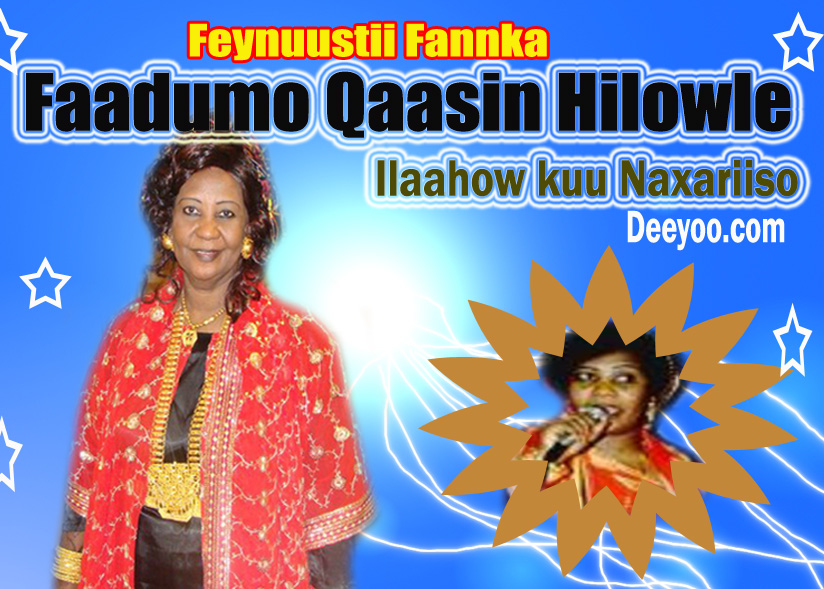 Hibo Mohamed is probably one of the top four or five women singers in all of the history of Somali female singing. All performed here at the Concert Hall of Macalester College, which is a lovely facility, for two nights. The first night was about love, whether gained or lost, and the emotional dimensions of human romantic engagement. The second night was about national concerns—war and peace, dispossession, the condition of being a refugee, and what has become of the Somali people in these last 22 or 23 years. So the first night was quite convivial, a lot of clapping and whistling as the audience was so wonderfully taken by the artists—just uplifting. The second night was also rich, but of course somber, quite painful for people to listen as the artists sang in their own beautiful voices, accompanied by beautiful music, the curse that has befallen the Somali people as they have lost their country their rightful place in the continent and beyond.
Hibo Mohamed is probably one of the top four or five women singers in all of the history of Somali female singing. All performed here at the Concert Hall of Macalester College, which is a lovely facility, for two nights. The first night was about love, whether gained or lost, and the emotional dimensions of human romantic engagement. The second night was about national concerns—war and peace, dispossession, the condition of being a refugee, and what has become of the Somali people in these last 22 or 23 years. So the first night was quite convivial, a lot of clapping and whistling as the audience was so wonderfully taken by the artists—just uplifting. The second night was also rich, but of course somber, quite painful for people to listen as the artists sang in their own beautiful voices, accompanied by beautiful music, the curse that has befallen the Somali people as they have lost their country their rightful place in the continent and beyond.
So that's what we did in 2004. It was never done before, certainly here in Minnesota. I don't know about other parts of the United States. Those recordings are now in the archives. And people continue to ask if we could do it again, 10 years later. Maybe this year, they say. But I'm not sure. Not yet. We’re not ready for that yet. It takes a great deal of resources to put all this together. In these very difficult times, raising a $100,000 is not easy. But what I did do, though, was in 2010, as I was stepping down from the deanship, we had a spring festival, which happens at Macalester every year. In 2010, we were sponsored by the Institute to focus on Somalis again, and their cultural music. We brought some musicians--not quite as well-known and at that level of Hodeidi and Hibo Mohamed, and Faadumo Qaasim, but were quite impressive. They were what you might call regionally distinguished—we had a very good time.
In fact, one of the distinctive things that we did in 2010 was to incorporate the choir of Macalester College, all of them non-Somalis, mostly American students. We taught them to sing lines from "Jowhara Iyo Lula.” It took a lot of practice, but they were stunning once they mastered this with the conductor. They were about 25 students, dressed up, and we sang together at the chapel that evening. I sang with them, and with the Somali musicians. And it was magnificent. The voices were just superb, and the way they latched on to the Somali tone, and the words—it made the Somalis who were in the audience cry--they couldn't believe the level of the performance. Some of them even said that these were better than the celebrated Somali singers. It was one of the most rewarding parts the festival.
That's a wonderful story. Well if you ever do manage to do something like that again, please let us know. We would love to be there.
Let me just add one sentence or two on the role of Somali musical heritage in this age of decomposition. I think one of the devastating agonies of the present—as the Somali society continues to get bogged down in this self-destructive "othering" of each other, and the death of Somali national institutions, and increasing regionalization of identity—is that that musical, cultural, poetic and drama production, playwriting, all of those have suffered a good deal. In my estimation, what has been happening these last 20 years is a demonstration of how politics, when it becomes so corrosive and bankrupt, and leadership becomes so mediocre and self-serving, does not only damage the material life of people’s daily lives by spreading pauperism and destitution, and increasing civil strife. These things are visible immediately, and maybe people want to do something about it. But what is undeniable is this: the erosion, if not the drying up, of the Somali poetic imagination at that high level. I know of no great poetry or playwrights. I know of no great songs. And I know of no great musicians that are now sprouting.
The artistic imagination of the Somali people has dwindled. There appears to be limited talent everywhere, and the diasporic life does not seem help. I always thought that immense and historically difficult moments in the lives of societies produced exceptional insights that come out of that pain. In the Somali case, going on 20 years and more, we have no evidence of that. In fact, it's the opposite. There is very little in terms of supreme cultural poetic production. And that's sad.
Well, that is a dark assessment. On that somber note, I thank you very much for your help with this. This is been very, very interesting.
Thank you. I’ve enjoyed this conversation.








